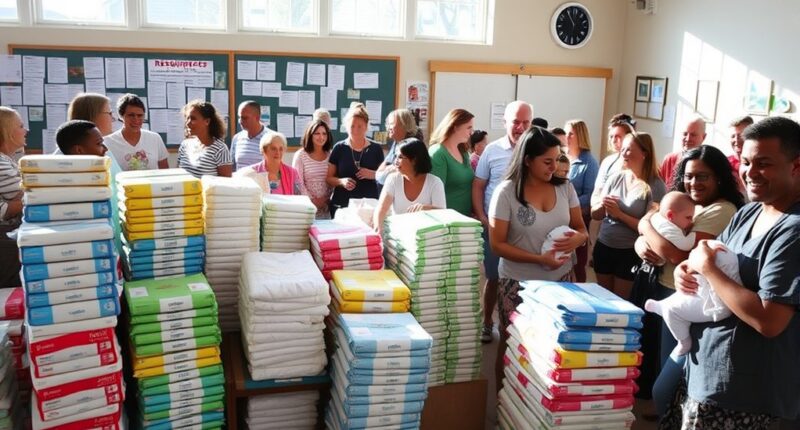If you’re looking for free or low-cost diaper programs, you’re not alone. Many communities have diaper banks and support networks that help families in need. These programs often rely on donations and local partnerships to distribute diapers effectively. Government initiatives also provide funding for diaper assistance. By accessing these resources, you can ease the financial burden on your family. Keep exploring to discover more about the available support in your area and how to get involved.
Key Takeaways
- Many local diaper banks provide free or low-cost diapers through community partnerships, often accessible via online directories or local organizations.
- Federal programs like the Improving Diaper Need Act and state initiatives offer financial assistance specifically for diaper purchases, benefiting low-income families.
- Community awareness campaigns, such as National Diaper Need Awareness Week, help mobilize donations and increase resources for families in need.
- Home visiting programs can connect families directly to diaper resources, identifying those who may be unaware of available assistance.
- Innovative distribution methods, including door-to-door delivery, enhance access to diapers for families facing transportation challenges.
Understanding Diaper Need in the Community
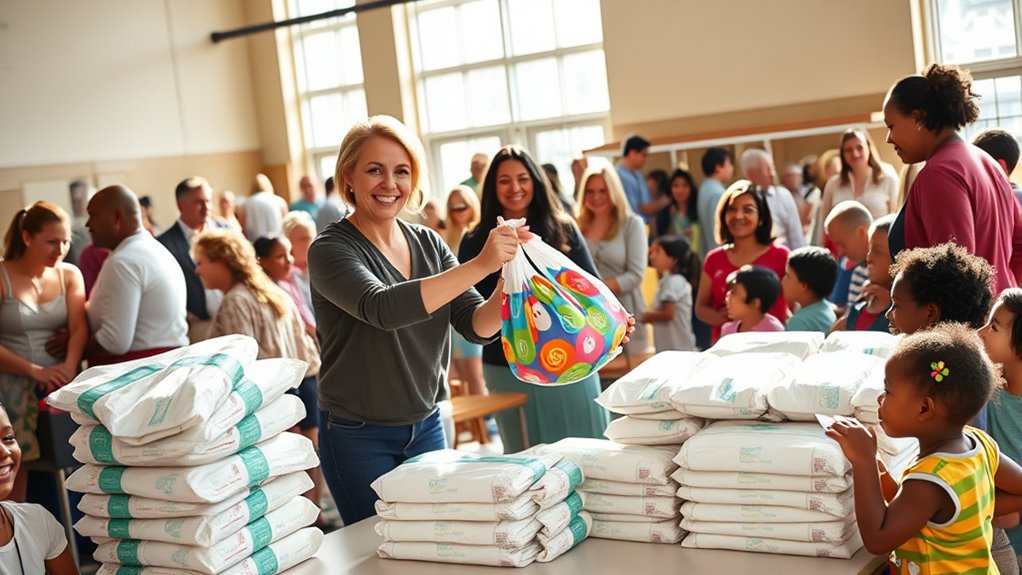
Understanding diaper need in the community is vital because it affects a significant number of families. Nearly one in three households in the U.S. struggles with diaper affordability, with about 50% of families with young children facing this challenge.
This financial burden can consume up to 21% of TANF benefits for low-income families, making it difficult to meet other basic needs. Diaper need disproportionately impacts Hispanic families and those with incomes below $100,000.
Additionally, the lack of diapers can hinder access to childcare, forcing parents to miss work or school. With over 5 million children affected, addressing diaper need is essential for fostering healthier, more stable family environments and supporting child development. Newborn feeding options can also significantly alleviate the stress of budgeting for essential baby items.
Overview of Diaper Bank Networks

Diaper bank networks play an essential role in addressing the pressing need for diapers within communities across the U.S. Headquartered in New Haven, CT, the National Diaper Bank Network supports over 240 member banks, helping them provide critical resources and assistance.
They offer guidance on starting and sustaining local diaper banks, ensuring diverse communities, from urban to rural, can access necessary supplies. While diaper banks endeavor to meet demand, challenges like transportation issues and limited state coverage persist.
Members adhere to nonprofit best practices and rely on private donations for funding. By collaborating with local organizations, diaper banks amplify their impact and raise awareness about diaper need, vital in fostering community support and engagement.
Federal Initiatives Supporting Diaper Access
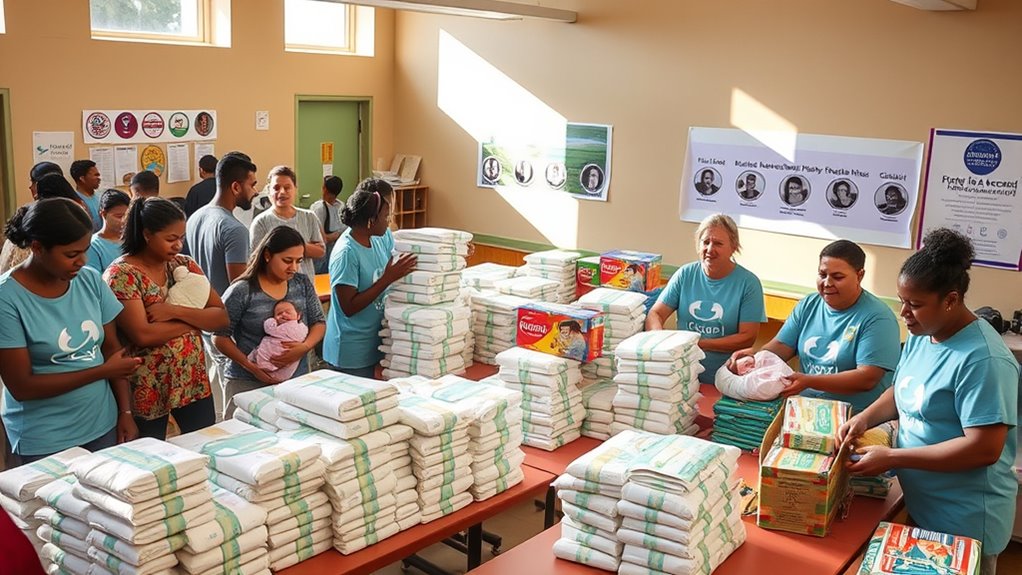
While diaper banks endeavor to meet the needs of families, federal initiatives play a significant role in expanding access to diapers across the country.
Legislation like the Improving Diaper Need Act of 2023 aims to classify diapers as qualified medical expenses, easing financial burdens.
The End Diaper Need Acts propose substantial funding, with annual allocations of $100 million and $200 million for distribution programs.
The Federal Diaper Distribution Pilot Program, initially funded with $8 million, is expanding its reach to more states and tribes.
These efforts not only alleviate economic stress for low-income families but also improve overall health and well-being, reducing barriers to childcare and fostering greater participation in the workforce.
State-Level Support Programs

As states recognize the pressing need for diaper access among low-income families, they’ve implemented various support programs to alleviate financial burdens.
For instance, California’s AB 480 provides $30 monthly for diapers, while Georgia families enrolled in TANF can receive 300 diapers monthly for four months.
In Minnesota, a budget allocation of $125,000 supports diaper distribution through food shelves.
New York offers an $80 subsidy every three months for children under two, and Tennessee plans to cover 100 diapers monthly for qualifying children starting Fall 2024.
These initiatives reflect a growing commitment to ensuring families have the essentials they need, highlighting the importance of state-level support in addressing diaper scarcity and improving overall family well-being.
Health and Economic Impacts of Diaper Scarcity

Accessing clean diapers is essential not only for a child’s health but also for the overall well-being of families. When you can’t provide adequate diapers, your child may suffer from skin irritations, infections, and even developmental issues.
Prolonged exposure to soiled diapers increases the risk of urinary tract infections and impacts their motor and cognitive growth. Economically, diaper scarcity can limit your job opportunities and push your family into financial instability, forcing tough choices between diapers and other necessities.
About 25% of parents miss work due to inadequate diaper supplies, further straining your household. The lack of stable access to diapers can perpetuate cycles of poverty and worsen existing socioeconomic disparities, affecting both you and your child’s future.
Community-Based Solutions and Programs

Community-based solutions and programs play an essential role in addressing diaper scarcity, guaranteeing families receive the support they need. By forming multi-agency collaborations, these programs distribute diapers through community action agencies and diaper banks.
They also provide wraparound services, connecting families to job training and housing support. To identify families in need, programs use eligibility criteria based on SNAP status or current services received.
Funding from federal, state, and private sources helps expand services, reaching more families effectively. Regular distributions and bulk purchasing of diapers guarantee consistent support, while community engagement raises awareness and drives donations.
The Role of Volunteers in Diaper Distribution
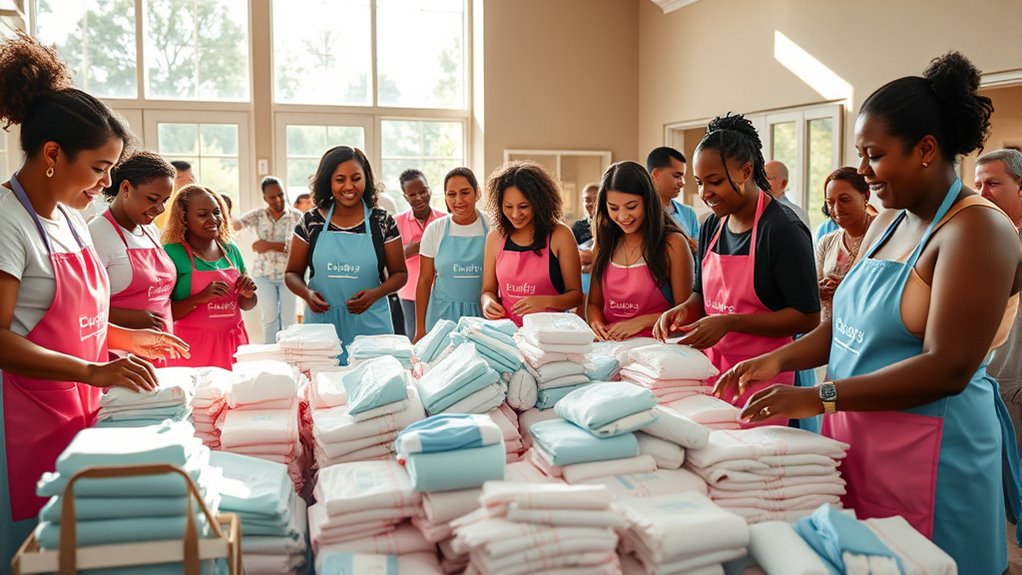
While diaper distribution programs often rely on community support, volunteers are the backbone of these initiatives. Over half of these programs depend entirely on volunteers like you.
You’ll help sort, pack, and distribute diapers to families in need, ensuring they receive the correct sizes and quantities. Your responsibilities include setting up distribution events and managing intake for participants, all while communicating important messages effectively.
You might even lift and move supplies, so being able to handle up to 25 pounds is essential. By volunteering, you’re not just assisting with logistics; you’re making a significant impact on families facing diaper need, reducing stress and health risks while supporting community outreach and engagement.
Your efforts truly matter!
Cost-Effective Alternatives for Families
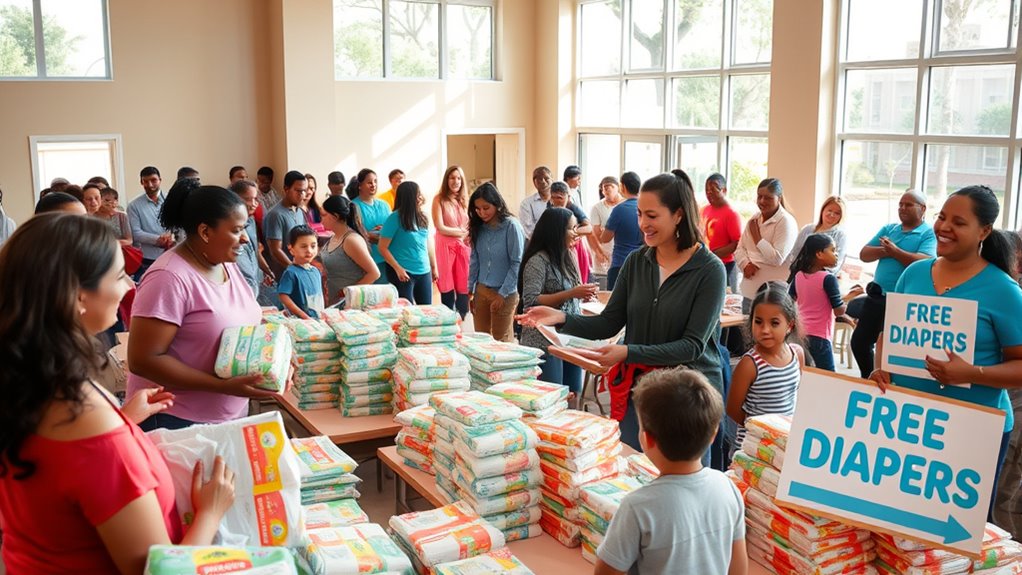
How can families facing financial challenges find affordable solutions for diapering? Start by exploring diaper banks, which offer free diapers to low-income families, much like food banks. Additionally, understanding the importance of financial planning can help families budget for essential needs, including diapering. Humor can also be a helpful tool for parents to bond over the challenges of parenting, similar to how seniors texting humor brings joy and connection among older adults. It’s important to remember that open communication within families can alleviate stress related to financial burdens.
Families in need can turn to diaper banks for free diapers, similar to food banks, providing essential support during tough times.
Consider cloth diapering options, like flat or prefold diapers, which aren’t only budget-friendly but also eco-conscious. You can even make DIY diapers from old t-shirts or other fabric you already have.
Look into disposable diaper subscriptions for affordable, eco-friendly options. Don’t forget about government assistance programs, such as diaper vouchers, which some states provide.
Finally, connect with local non-profits like Babies of Homelessness for additional resources. With these alternatives, you can manage diapering costs while ensuring your baby’s needs are met. Additionally, regular veterinary check-ups can help ensure that parents are also aware of their child’s overall health and any potential needs for medical supplies.
Advocacy for Increased Diaper Accessibility
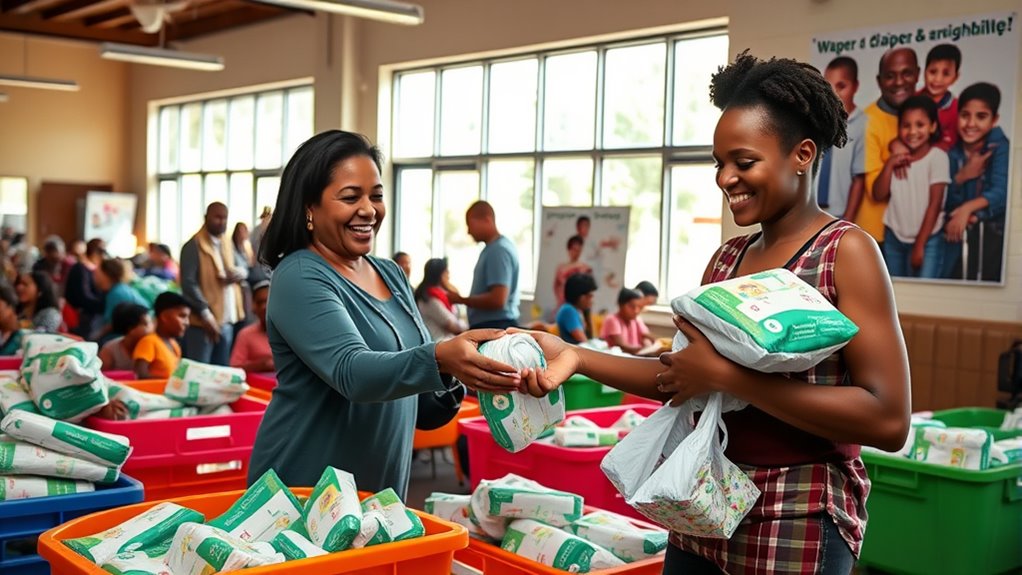
Advocating for increased diaper accessibility is essential for families facing financial hardships, especially since many lack the resources to meet their children’s basic needs.
Diaper banks play a significant role, but they only reach a small percentage of those in need. Partnering with local organizations can enhance distribution and improve health outcomes.
Raising community awareness about diaper insecurity is important; many remain unaware of its prevalence. Home visiting programs can identify families needing support and connect them with resources.
Campaigns like National Diaper Need Awareness Week mobilize donations and raise awareness.
Future Directions for Diaper Support Policies

Increased awareness around diaper insecurity paves the way for forward-thinking policies that can greatly enhance support for families in need.
Strengthening current programs, like the Diaper Distribution Demonstration Pilot, guarantees innovative distribution methods reach more families. The proposed Duckworth-Cramer End Diaper Need Act could allocate $200 million annually for diaper distribution, while allowing Medicaid to cover medically necessary diapers.
Expanding SNAP and WIC to include diapers would also alleviate financial strain. Community partnerships enhance distribution through innovative models like door-to-door delivery.
Frequently Asked Questions
How Can I Find a Local Diaper Bank Near Me?
To find a local diaper bank near you, start by checking the National Diaper Bank Network’s website for a member directory.
You can also call or visit 2-1-1.org to connect with local resources.
Don’t forget to reach out to community organizations, food pantries, or nonprofits in your area—they often provide diaper assistance.
Finally, keep an eye out for local events or drives that might offer free or low-cost diapers.
Are There Eligibility Requirements for Receiving Diaper Assistance?
Finding assistance can feel like maneuvering through a maze, but eligibility for diaper assistance often hinges on a few key factors.
You typically need to provide proof of income, identification, and sometimes documentation about your child’s needs from a doctor. States may have different age requirements, and staying engaged with the program is vital.
How Often Can Families Receive Free Diapers From Programs?
You can typically receive free diapers from programs on a regular basis, but it really depends on the specific program’s funding and resources.
Some might distribute them monthly, while others may have less frequent schedules due to limitations.
It’s important to check with the program directly to understand their distribution frequency and any eligibility criteria.
Staying informed will help you make the most of the assistance available for your family’s needs.
What Types of Diapers Are Typically Offered Through These Programs?
Oh, the glamorous world of diapers!
You’ll find mostly disposable ones, the kind that make you question your life choices. Some programs even offer cloth diapers for the eco-warriors among you.
Wipes and creams? They’ve got those too, because why not add a touch of luxury to diaper duty?
Infant and toddler sizes are usually available, ensuring your little one’s backside is well-covered, no matter the stage of their diaper-wearing adventure.
How Can I Volunteer to Help at a Diaper Distribution Event?
To volunteer at a diaper distribution event, start by reaching out to your local diaper bank.
They often have scheduled events where you can lend a hand. You can help with sorting, packing, or even distributing diapers.
Consider organizing a diaper drive with friends or your workplace to boost participation.
Don’t forget to spread the word on social media! Your involvement can make a significant difference in addressing diaper need in your community.
Conclusion
In a world where every child deserves a clean diaper, consider this: a mother once shared how a simple pack of diapers transformed her family’s life, easing stress and allowing her to focus on nurturing her child instead of worrying about resources. Just as a sturdy bridge connects two shores, access to diaper programs bridges the gap between struggle and stability. By advocating for increased accessibility, we can guarantee every family finds the support they need to thrive.
